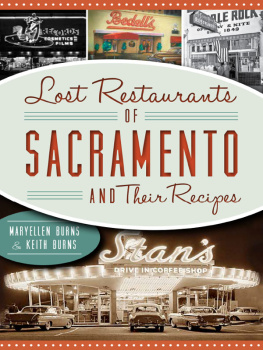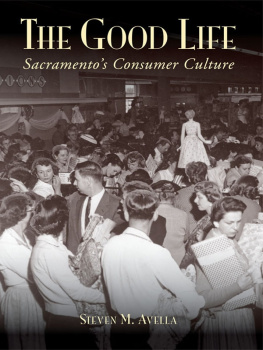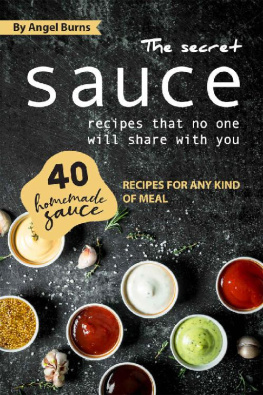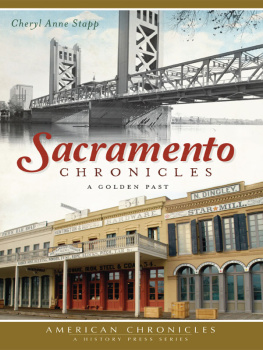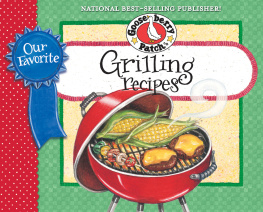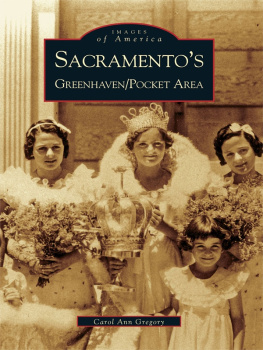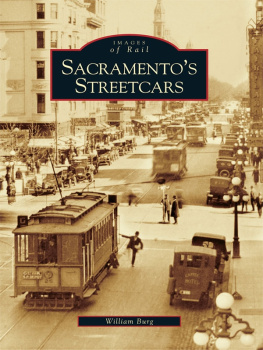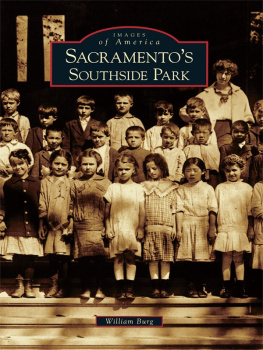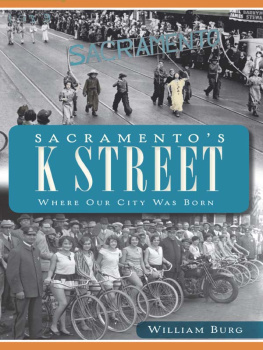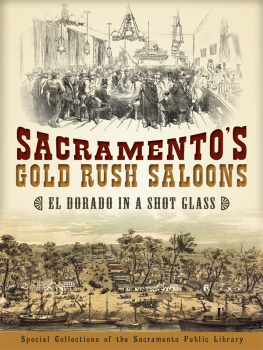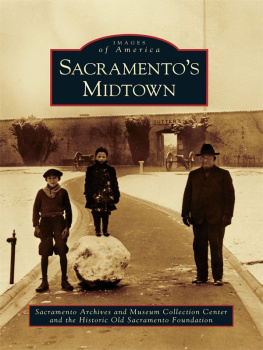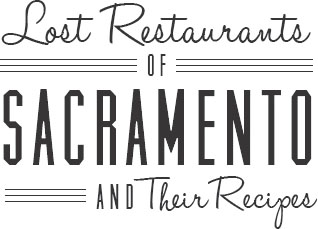
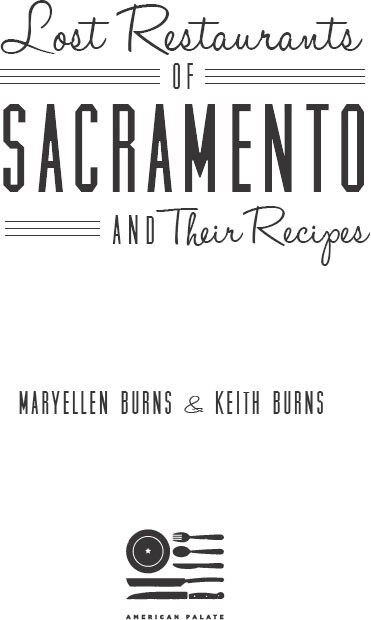
Published by American Palate
A Division of The History Press
Charleston, SC 29403
www.historypress.net
Copyright 2013 by Maryellen Burns and Keith Burns
All rights reserved
Cover: Images provided by Sacramento Public Library, Center for Sacramento History and Bob Miller.
First published 2013
e-book edition 2013
Manufactured in the United States
ISBN 978.1.62584.041.7
Library of Congress CIP data applied for.
print edition ISBN 978.1.60949.973.0
Notice: The information in this book is true and complete to the best of our knowledge. It is offered without guarantee on the part of the author or The History Press. The author and The History Press disclaim all liability in connection with the use of this book.
All rights reserved. No part of this book may be reproduced or transmitted in any form whatsoever without prior written permission from the publisher except in the case of brief quotations embodied in critical articles and reviews.
To our parents, Rose and Harry Burns, who introduced us to fine dininggreasy spoons, roadside diners, hamburger joints and hot dog stands.
To Leo Dabaghian, aka the Great Dab, who made this book possible and eating out an adventure.
Contents
Acknowledgements
This book could not exist except for a lot of help from friends, family and colleagues who helped research, edit and interview; provided anecdotes and essays; and endured endless talk about Sacramentos lost eateries. Our heartfelt thanks to Scott Burns, Sister Sheba, Joy Gee, Arianne Laidlaw, Francis Ng, Lawrence Fox, Connie Geffert, Rick Castro, Stephanie Georgieff, Isaac Gonzalez, Emily DePol and Kelley Woodward.
Leo Dabaghian, Maryellens spouse, could claim co-authorship. He slaved over each word, chauffeured and took out his wallet when we got a whopping bill for photo permissions. Also, as the deadline approached, he slogged and flogged us onward. Now thats true love.
Bob Miller generously supplied the watercolors gracing the cover and interior. He captures, in a way words never could, the character, texture and essence of Sacramentos gone-but-not-forgotten places. Our profuse and heartfelt thanks!
We are deeply indebted to the staff of the Sacramento Public Library, in particular the Sacramento Room. Amanda Graham, Tom Tolley and James Scott gave us unlimited access to a treasure trove of materialsbooks, maps, pamphlets, postcards, photographs and old city directories from Sacramentos earliest days. Tom and James deserve special thanks: Tom, a former bartender at the Coral Reef, provided a firsthand account. James shared his work on early Sacramento saloons. Our Sacramento Public Library card opened up vast treasures of information via online databases.
The Center for Sacramento History has a dedicated staff, knowledgeable beyond measure. We spent most Thursdays there researching this and other food- and history-related projects. Archivist Pat Johnson is irreplaceable. Ruth Craft, a volunteer and friend, tracked down obscure and vital material.
Our colleagues at the Sacramento County Historical Society are inspirational. Each deserves mention, but a special nod to William Burg, consummate Sacramento author and historian; Pat Turse, who kindled a passion for history; Tom Herzog, book store owner and Delta historian; and Dr. Bob LaPerriere, who opened his rare (and valuable) Sacramento history and cookbook collection to us.
We are grateful to the food reporters at the Sacramento Union and the Sacramento Bee from the 1850s forward. A special note to Elaine Corn, former Bee food editor, now friend and colleague. Elaines husband, David SooHoo, is a walking encyclopedia. Sacramentos dining scene probably suffered its biggest loss when the two of them closed their last restaurant.
A special nod to eateries that fed us when we stopped cooking, letting us write at their counters or tables for hours: Market Club, Willies Hamburgers, Waffle Square, Pancake Circus, Fortune House, Afghan Kabob House, Casablanca, Blackbird, Temple, Kebab House and the many others we cherish. Thanks to the staff of Taylors Market and Corti Brothers, past and present, suppliers of top-quality meats, fruits, vegetables and wines to many small restaurants and caterers (including In Any Event, Maryellens original entre into the world of food). To Gary, special thanks. Hell know why.
Our editor, Aubrie Koenig was a delight. She made the process run smoothly, given we took it on with only a few months of research/writing time.
Lost Restaurants of Sacramento has many contributors. Their voices tell the story much more authentically than we could. Thanks to Joan Alby, Thom Allen, Albert Breck, Martha Breck, Don Burns, Scott Burns, Clarence Caesar, Rick Castro, Leo Dabaghian, Bonnie DAlessandro, Josie DAlessandro, Paul DAlessandro, Jeannette Davis, Susan De La Cruz, Lawrence Fox, Howard Frasinetti, Joy Gee, Mary Gee, Louise Gonsalves, Randy Grenz, Tom Haseltine, Thomas Herzog, John Hull, Arianne Laidlaw, Toni Lane, Bob Miller, Elaine Nakamoto, John and Kathy Newman, Myron Owen, Maurice Read, Gail Robbin, Craig Rutledge, Ken Saunders, Norm Sayler, George Sullivan, Gordon Takamoto, Maury Temple, Mavis Temple, Tom Tolley, Socorro Zuniga and all the others who shared their stories.
Introduction
Sacramento is situated at the confluence of the Sacramento and American Rivers, an area full of natural bounty. With its rich stew of hard-working immigrants, it became, early on, a major crossroads for food, wine, beer and many other agricultural products that flowed to the nation and the world. Along the way, it begot a unique and rich culinary history.
It provided the finest American restaurants with caviar from Sacramento River sturgeon. Our canneries, food manufacturers and bottlers produced Sacramento Tomato Juice, Libbys Peaches, Campbells Soup, Kraft Cheese, Coca-Cola, Hostess Cupcakes and Wonder Bread and sent it off by rail, sea or roadway to towns small and large. A&W Root Beer popularized drive-ins, carhops and fast food franchising. Shakeys gave us a hankering for pizza. Our test markets for new food products and chain restaurants changed eating habits worldwide.
When immigrant Chinese workers finished building the railroads, reclaiming Delta farmland and building our levees, they turned to the restaurant trade, as has every new immigrant group since. Innovators such as Theodore Judah utilized improvements in cold storage on trains to allow restaurants nationwide to feature our bountiful agricultural productsfresh, canned and frozen.
Our gilded age, the growth of our local breweries, the emergence of counter culture, Prohibition, the Depression, the war years and drive-in mania mirrored cities around the country. But in Sacramento there was something truly awe-inspiring about the political watering holes, from the shenanigans that moved the legislature here permanently in 1854 to the rough-and-tumble politics of Jesse Unruh and Willie Brown a century later.
So, where are we after almost 175 years of eating out?
Boston gave us baked beans and clam chowder. San Francisco is known for sourdough bread, crab sold fresh off the wharf and innovative hotel creations like Celery Victor and Green Goddess Dressing. Does Sacramento have a signature dish? Well, no and yes. Most signature dishes began as a specialty of a particular restaurant. Nevertheless, they define Sacramento. Frank Fats banana cream pie, Americos fettuccini with asparagus and mushroom and Merlinos Orange Freeze present a taste of who we were and are.
Next page
